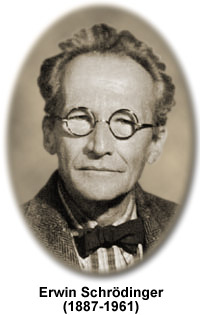Erwin Schrödinger
(1887-1961)

The Austrian physicist Erwin Schrödinger made fundamental advances in establishing the groundwork of the wave mechanics approach to quantum theory. Born in Vienna, Schrödinger was raised in a household where both English and German were commonly spoken, his mother being part English and part Austrian. Thus, he was bilingual at a very early age and was initially educated at home by a private tutor. In 1898, Schrödinger was enrolled at the Akademisches Gymnasium, graduating from the institution in 1906 with a broad education. Subsequently he entered the University of Vienna, where he studied mathematics, analytical mechanics, and theoretical physics. In 1910, Schrödinger received his doctorate and accepted a research post, but was obliged to leave upon the outbreak of World War I. Following his military service, in 1921, he settled in Zurich, where he taught at the university. Five years later, Schrödinger would develop his foundational work in the field of quantum wave mechanics.
In 1924, a French graduate student named Louis de Broglie completed his thesis on quantum physics. Within the document was a groundbreaking theory that helped revolutionize the field and led Schrödinger to develop the famous equations that carry his name. According to de Broglie, electrons and other forms of matter exhibit a dual nature that enables them to sometimes behave as particles and sometimes as waves. Prior to de Broglie’s work, several scientists were convinced of the duality of light, but he was the first to suggest that the same was true for other forms of matter. Influenced by de Broglie’s work, which had gained additional weight due to the support of Albert Einstein, Schrödinger attributed the quantum energies of the electron orbits in the atom thought to exist to the vibration frequencies of electron matter waves, now known as de Broglie waves, around the nucleus of the atom. This idea led to Schrödinger’s notion that an electron wave would exhibit a fixed quantum of energy, an idea that was fundamental to the development of his wave mechanics, which were based upon calculations more familiar to most scientists than those used previously by Werner Heisenberg to establish his opposing matrix mechanics explanation of electrons. Due to this familiarity and the greater ease that it could be used to visualize atomic events, Schrödinger’s wave mechanics quickly gained acceptance by many physicists as an alternative to Heisenberg’s matrix mechanics. However, there was a certain amount of dissidence among those in the field until Schrödinger proved that matrix mechanics and wave mechanics provided equivalent results, so that they were essentially the same theory expressed via different means.
The year after Schrödinger published his groundbreaking work on wave mechanics, he was offered the prominent post previously held at the University of Berlin by Max Planck, which he accepted. In 1933, however, Schrödinger decided to leave Germany due to the rise of Hitler and the Nazi party, even though, as a Catholic, he was not in any direct danger at the time. He first went to Oxford, where he held a fellowship for a time, and was then offered a position at Princeton, but did not accept it. Eventually, in 1936, he decided to accept a post at the University of Graz in Austria, but when the Nazis invaded the country soon after, Schrödinger was dismissed due to his earlier affront to the party. He and his wife, Anny, fled Austria and eventually established themselves in Ireland, where Schrödinger joined the Institute for Advanced Studies in Dublin.
Despite his political problems and frequent moves in the 1930s, Schrödinger continued to carry out his theoretical work. He is particularly known during this period for positing a vivid example of the paradoxes associated with quantum mechanics. Often referred to simply as Schrödinger’s cat, the famous hypothetical scenario involves a cat placed in a steel chamber with a Geiger counter containing an amount of radioactive material so small that there is an equal probability that in one hour one of the atoms will or will not decay. If one of the atoms does decay, it will cause a chain reaction that results in the release of hydrocyanic acid into the steel chamber, poisoning the cat. However, until the chamber is actually opened, it is impossible to know if the cat has been poisoned or not. Indeed, according to Schrödinger and quantum law, the cat is paradoxically both alive and dead after an hour in the box in a superposition of states. This superposition is only resolved when the fate of the cat is determined by opening the chamber. Schrödinger’s cat is often used as an argument against a blurred model of reality, in which the cat in the chamber would be smeared into a state between the two possibilities, being both partially alive and partially dead.
In his later years, Schrödinger renewed an earlier correspondence with Einstein and, similar to him, began to concentrate his efforts on developing a unified field theory. His work in this area, however, was not any better received than that of Einstein, who was often said to be wasting his time on the fruitless endeavor. Schrödinger, however, had many other interests and published such diverse works as What is Life (1944), Nature and the Greeks (1954), and My View of the World (1961), the latter of which expounded an outlook similar to the Vedanta branch of Hindu philosophy. In 1955, he retired from the Institute for Advanced Studies and subsequently returned to Vienna. He died following a prolonged illness on January 4, 1961. For his significant contributions to science, Schrödinger was bestowed with many honors, including the Nobel Prize for Physics, which he shared with Paul Dirac in 1933.
